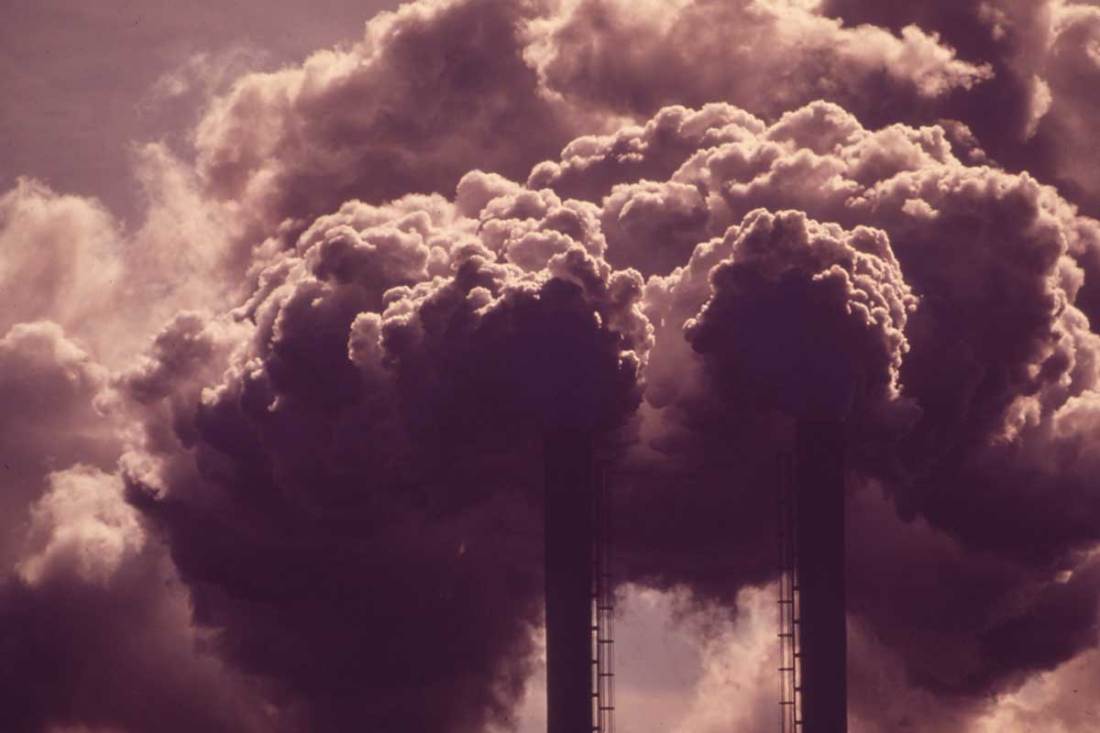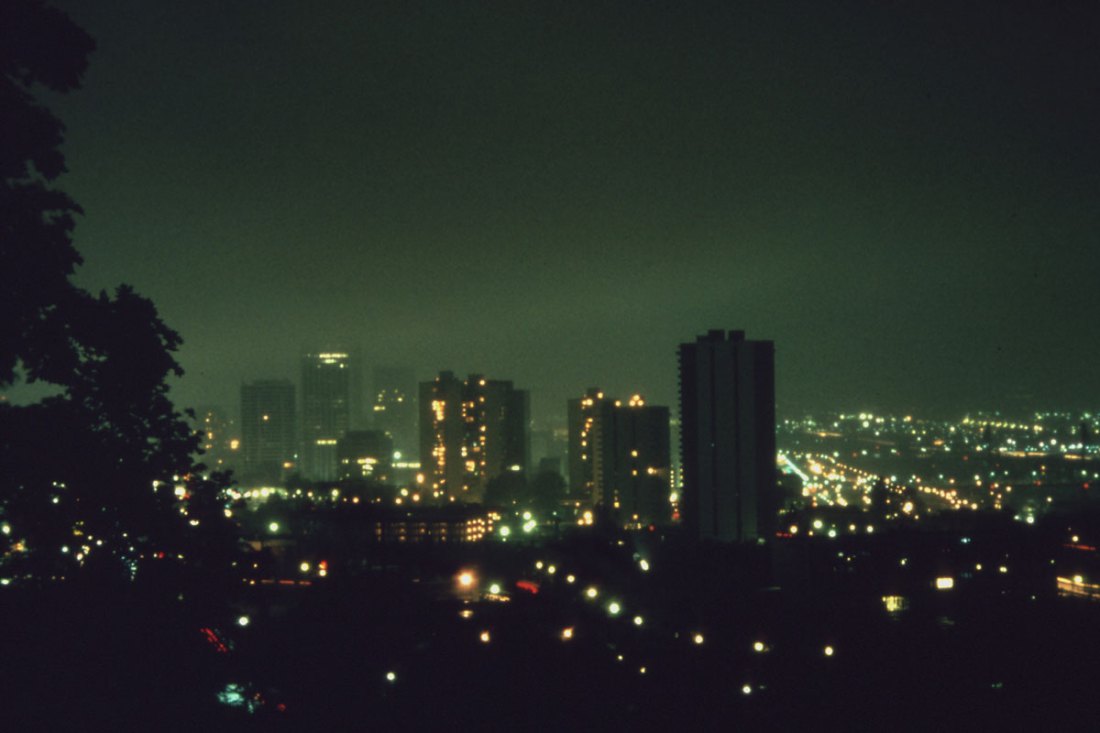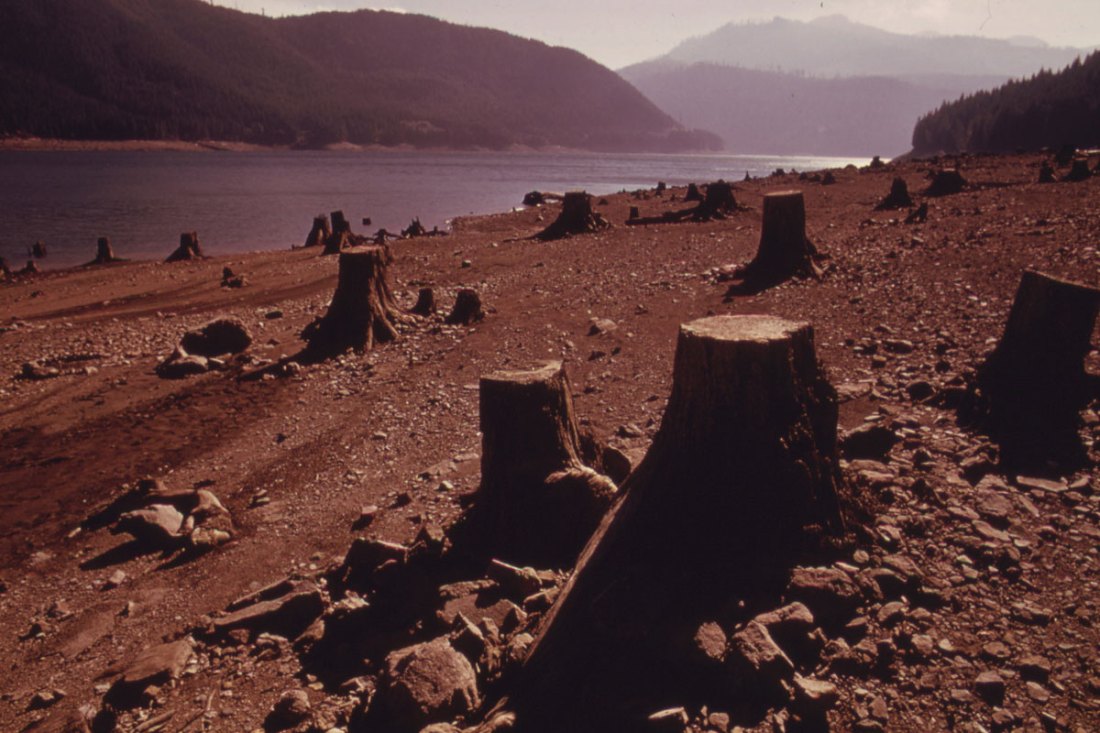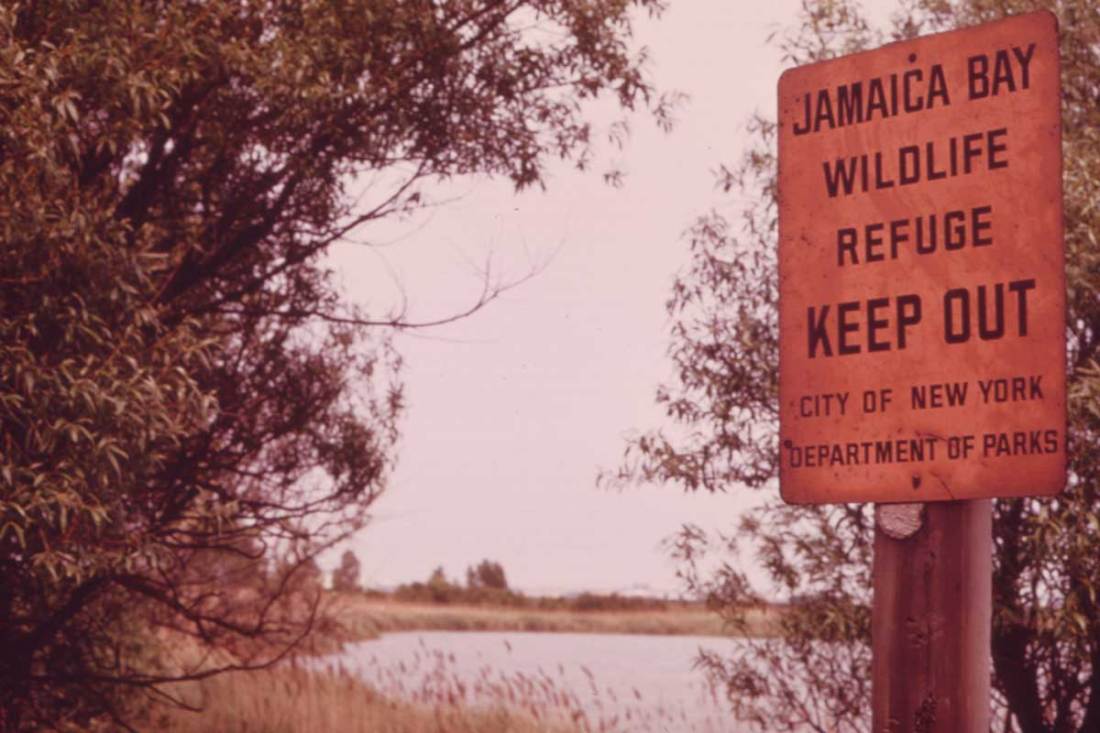Do we need a new DOCUMERICA? The recent rediscovery of the DOCUMERICA photographic archive from its long period of dormancy provides an opportunity to revisit a unique collection of environmental photographs and to ask whether a project from 1970s America is relevant to the ecological crises of the 21st century.
In April 2013, Claire O’Neill writing for the National Public Radio posed the question do we need a new Documerica? O’Neill made no attempt to answer her own question so this essay attempts to take the question seriously by visiting DOCUMERICA, so to speak. After all, there is always much at stake when we talk about people and the environment.

Deer hunters at their permanent camp amuse themselves between real kills. They leave grain at the deer’s feeding places and wait until sunset when the deer come out to feed. Hiding behind deer blinds, the hunters find the animals an easy prey, November 1972. Marc St. Gil\U.S. National Archives (412-DA-3657).
DOCUMERICA was a United States federal documentary photography project announced in 1971 by the then newly created Environmental Protection Agency (EPA). It operated from 1972 until 1977, during which time it amassed some 22,000 photographs on environmental topics from across America into its archive.
The project had two main aims 1) to establish a baseline of environmental problems against which it would measure progress over time and 2) to show the connections between people and the environment. That these aims were to be both met using photography showed an understanding by the project’s creators about the nature of photography as being both science and social science.
A potted history of DOCUMERICA
DOCUMERICA was the vision of its project director Gifford Hampshire. Hampshire was a former picture editor for National Geographic magazine and had grown up in Kansas during the Dust Bowl, which was so iconically photographed by the Farm Security Administration (FSA) some 40 years earlier. DOCUMERICA was to follow in the lineage of this famous photographic program, though instead of documenting rural poverty, DOCUMERICA would be guided by the mission of the EPA — to protect human health and the environment.
Working with FSA photographer Arthur Rothstein, Hampshire handpicked photographers and sent them across America to document environmental problems according to a specific topic or location. The topics of interest included, water pollution, air pollution, noise pollution, communities under pressure, human health, employee working conditions, earth friendly homes, inner city life, fuel shortages, flood damage, and strip mining.
The photographs that started coming back from DOCUMERICA’s photographers began to provide evidence, the intended “visual baseline” of the effect that people were having on the environment and the effect that the degraded environment was in turn having on people.
People and the environment were indeed connected as Hampshire had pointed out at the beginning of the project stating “where you see people, there’s an environmental element to which they are connected.”
 Sulphur fumes pour out of the smokestacks of the Olin Mathieson Chemical Plant, July 1972 Marc St. Gil/U.S. National Archives (412-DA-3750).
Sulphur fumes pour out of the smokestacks of the Olin Mathieson Chemical Plant, July 1972 Marc St. Gil/U.S. National Archives (412-DA-3750).
 Children play in yard of Ruston home, while Tacoma smelter stack showers area with arsenic and lead residue, August 1972 Gene Daniels/U.S. National Archives (412-DA-2753).
Children play in yard of Ruston home, while Tacoma smelter stack showers area with arsenic and lead residue, August 1972 Gene Daniels/U.S. National Archives (412-DA-2753).

Black lung x-rays from patients of Dr. A.H. Russakoff pulmonary disease specialist and pioneer air pollution fighter in the area, July 1972. LeRoy WoodsonU.S. National Archives (412-DA-2987).
 Contaminated water in drainage ditch behind Pittsburg Glass Co, June 1972. Marc St. Gil\U.S. National Archives (412-DA-3638).
Contaminated water in drainage ditch behind Pittsburg Glass Co, June 1972. Marc St. Gil\U.S. National Archives (412-DA-3638).

Mary Workman holds a jar of undrinkable water that comes from her well, and has filed a damage suit against the Hanna Coal company. She has to transport water from a well many miles away. Although the coal company owns all the land around her, and many roads are closed, she refuses to sell, October 1973 Erik CaloniusU.S. National Archives (412-DA-12346).
DOCUMERICA was shared with the public through a series of exhibitions. The first, DOCUMERICA 1 was shown in August 1972 and consisted of 155 photographs shown for six weeks at the Corcoran Gallery in Washington D.C. Later, the Smithsonian Institution Traveling Exhibition Service (SITES) took responsibility for exhibiting the photographs and a travelling exhibition titled Our Only World was created. This exhibition consisted of 113 photographs and toured the United States and also internationally between 1974 and 1978.
Only Our World successfully raised awareness of the environmental problems occurring in America and received favourable reviews. However, DOCUMERICA was not to survive the loss of one of its key supporters, William Ruckelshaus the first administrator of the EPA. In 1973, during the developing Watergate scandal, Ruckelshaus was appointed to the Federal Bureau of Investigation (FBI). With a change in leadership at the EPA and a round of budget cuts, DOCUMERICA was scaled back. Photography assignments effectively ended in 1976 and in the following year the project was officially ended.
DOCUMERICA Rediscovered
The recent rediscovery of DOCUMERICA, ‘lost’ during forty years of dormancy, has generated much interest in this unique collection of environmental photographs. It is reassuring that photographs of environmental problems in 1970s America can claim attention, and attention that is not limited to its country of origin. However, what is the nature of this interest? And can it provide a basis to argue that a new DOCUMERICA is needed?
In 2013, DOCUMERICA was the subject of a new exhibition at the United States National Archives, titled Searching for the Seventies: The DOCUMERICA Photography Project. The interest generated so far has largely been nostalgic in character, for the fashion, hairstyles, people, and places of 1970s America, or as an historical account of a unique photographic project. See: here, here, and here. O’Neill’s interest too, was nostalgic.
Nostalgia is premised upon the realist properties of a photograph, in so far as a photograph is believed to reliably represent reality. It is also from a realist view that photographs of smokestacks, polluted rivers, and adversely affected people gain their status as visual evidence of real environmental problems.
A closely associated view is a particular conception of an archive as a sealed container. Which may be put something like, the reality of the 1970s was recorded and sealed at the time of making and it can now be revisited by breaking the archival seal and looking inside the container. The Searching for the Seventies exhibition uses this view and invites the public to appreciate “from smokestacks to bell bottoms and leisure suits, these images are a fascinating time capsule of 1970s America.”
Viewing the archive as a sealed container creates a static, frozen in time and bounded, definition of the archival contents. When this is combined with the realist-historical view, variable readings of photographs are overlooked and the ability to conceive of a photograph as occurring in the present is obscured. On this view, the answering of — do we need a new DOCUMERICA? is restricted to the value placed on its evidentiary status.
A photograph can be understood to be occurring in the present in two ways. The photograph may capture an event in which the forces or logics which produced that event are still at work. Or, through the event of photography, which is a view of photography articulated by Ariella Azoulay that includes the viewer (spectator) of a photograph within the definition of photography.
The original Only Our World exhibition has also generated some retrospective interest. It has been strongly criticised on a number of fronts: for not proactively adding anything new to the environmental debate, for advancing technological solutions to environmental problems without also advancing alternatives, and for neglecting to question the underlying model of economic growth.
Criticism has also been aimed at the exhibition’s didacticism, which is made worse given the nature of its other failings. The level of environmental awareness in America during the 1970s was already high and photographs of illegally dumped rubbish and polluted rivers served to shock the public and build support for what ought to be done about it, recycling and pollution legislation for instance.
To answer whether we need a new DOCUMERICA, is to answer whether a project like DOCUMERICA is relevant today. To answer that, there needs to exist an understanding of what kinds of environmental problems do we have today? And what kinds of information do photographs provide? There also needs to exist an awareness of who is making, editing, and disseminating the photographs. Who is providing the access, context, and official readings of the photographs, and how critical or reflective are those readings? Do the readings provide conceptual openings or are they or narrowly didactic?
Taking the realist-historical view, a straightforward relevancy to today can be found through continued work on the “visual baseline,” Hampshire’s first project aim from which progress over time would be monitored. In this approach, photography becomes largely concerned with data collection and the capture of evidence into the archive.
An attempt to revisit the locations of DOCUMERICA was initiated in 2011 by the EPA as part of its State of the Environment Photo Project. The project encourages members of the public to submit photographs, via a public website, of the environment or to attempt to replicate photographs in the original DOCUMERICA archive under a ‘Then and Now’ section.

Columbia River 1973 & 2012. David Falconer (1973) and Craig Leaper (2012).

Moakley Park, South Boston, MA. Ernst Halberstadt (1973) and Roger Archibald (2012).

East Boston, MA 1973 & 2012. Michael P. Manheim.
The project makes no claim to be an attempt to monitor the visual baseline created by DOCUMERICA and so remains some distance in ambition from a new DOCUMERICA. The project does not employ photographers, relying instead upon the interest of voluntary photographers. It also distances itself from EPA policy and ends in 2013. The ‘Then and Now’ section of the project has proven less popular than the more general section which is populated largely with photographs of the natural environment, flowers, mountains, and birds.
In 2012, the Associated Press sent its photographers out on a small ‘then and now’ assignment to coincide with Earth Day of that year. The results of paying photographers proving more reliable as a method of data collection.
Both of these revisits, even though they were minor, capture change and continuity in the visual baseline. Reflecting the informational richness of a photograph. Dumping of rubbish in public spaces has become less visible and drains less vibrant in colour. While smokestacks continue to emit waste into the air and communities continue to make way for businesses. A nuclear power plant is now fully constructed, strengthened security fences are more prevalent, and closer attention is being paid to the management of roadside grass.
A visual baseline is relevant to environmental problems which are, or which have effects, that are also visual. It provides easy access to evidence of the effect that humans are having on the environment (and vice-versa) and over time permits an understanding of trends, allowing people to respond. Though this is not without its challenges, issues of physical access to take photographs and awareness of topics and selection of locations is not politically neutral.
Data collection and monitoring are by themselves not overly reflective processes and so the underlying processes (natural or cultural) are not deeply interrogated. It is also less suitable for environmental problems where the cause and effect is not well-known, as may be the case in systems with complicated feedback loops. Though photographs of adversely affected people and degraded environments may to help mobilise the necessary investigations to better understand the processes at work.
Photography between the poles
The second aim of DOCUMERICA, to show the connections between people and the environment offers a more promising place to find relevancy to today. This aim focused less on the poles of ‘people’ and ‘the environment’ and the effects upon each pole, and instead looked at the connections between the poles. These types of photographs offer deeper reflective potential by being less concerned with visual evidence. If the first aim emphasises data collection (writing), then the second aim emphasises reading (of photographs).
Environmental scientist Johan Rockström describes the challenges facing the 21st century as “the 3-6-9 reality.” We are moving towards 3°C warming (above pre-industrial levels), we are living through the 6th mass species extinction event, and we are committed to a population of 9 billion people by 2050. These are monumental challenges which seem to dwarf the challenges captured by DOCUMERICA. The problems we face globally today seem to be much bigger and different than those of 1970s America.
The effects are bigger, most certainly. The force that people collectively exert on the earth is now considered comparable to a geological force, which is captured so catchily in the suggested new name for a human-driven epoch, the Anthropocene.
This scale has increased the stakes and the number of stakeholders, so we must be alert to the limitations of the original Only Our World exhibition. To reiterate these criticisms: failure to add anything new to the environmental debate, advancing technological solutions to environmental problems without also advancing alternatives, neglecting to question the underlying models, and for being didactic. Each of these limitations are related to identifying what is ‘the problem.’
The hypothesis here is that the problems of the 21st century are not so different from the problems of 1970s America and that photographs read between the poles help to show this. Further, that through the ‘event of photography’ (Azoulay), these photographs help to prise apart conceptual limitations and so are important sources of information in a “3-6-9 reality.” Differences between the two photographic approaches can be described as follows:
Pole
- effect upon
- visual evidence (focus on known)
- this has happened (static, past)
- data collection (writing)
Between Poles
- relationship between
- evidence of? (focus on unknown)
- what is happening? (dynamic, present)
- reading
The broad guidance given to the DOCUMERICA photographers ensured that they captured much more than photographs of known environmental problems, “you’re always trying to photograph something that’s invisible… how somebody’s thinking,” said DOCUMERICA photographer Tom Hubbard.
 Veteran Miner Harold Stanley (right), talks to a young miner who has come into the mine for the first time after 40 hours of classroom training, April 1974
Veteran Miner Harold Stanley (right), talks to a young miner who has come into the mine for the first time after 40 hours of classroom training, April 1974
Jack Corn/U.S. National Archives (412-DA-13910).
 Miner Wayne Gipson (39) and his daughter Tabitha (3), December 1974. Jack CornU.S. National Archives (412-DA-14155).
Miner Wayne Gipson (39) and his daughter Tabitha (3), December 1974. Jack CornU.S. National Archives (412-DA-14155).
 Overall view of downtown Portland, at 8 pm in October, 1973 showing lack of commercial lighting during the peak of the energy crisis. The ban was issued by executive order of Oregon’s Governor, October 1973. David FalconerU.S. National Archives (412-DA-12954).
Overall view of downtown Portland, at 8 pm in October, 1973 showing lack of commercial lighting during the peak of the energy crisis. The ban was issued by executive order of Oregon’s Governor, October 1973. David FalconerU.S. National Archives (412-DA-12954).
 Detroit lake shown at an all-time low in the Fall of 1973 due to sparse snowfall and rain the year before. Lack of precipitation curtailed recreational use as well as water power for electricity at the dam, September 1973. David FalconerU.S. National Archives (412-DA-12932).
Detroit lake shown at an all-time low in the Fall of 1973 due to sparse snowfall and rain the year before. Lack of precipitation curtailed recreational use as well as water power for electricity at the dam, September 1973. David FalconerU.S. National Archives (412-DA-12932).

Deer Storage, November 1972. Marc St. Gil/U.S. National Archives (412-DA-3646).
 Jamaica Bay in the path of “The Atlantic Flyway,” the route of migrating birds, June 1973
Jamaica Bay in the path of “The Atlantic Flyway,” the route of migrating birds, June 1973
Arthur Tress/U.S. National Archives (412-DA-5378).

Ocean Reef Club at North Key Largo, circa 1975. Flip SchulkeU.S. National Archives (412-DA-6294).

Old spoil piles are flattened and planted in an attempt at reclamation. Dry climate and shallow soil permit only sparse growth, June 1973.
Boyd NortonU.S. National Archives (412-DA-6696).

Black muslim women dressed In white applaud Elijah Muhammad during the delivery of his annual savior’s day message In Chicago. The city is headquarters for the black muslims. Their $75 million empire includes a mosque, newspaper, university restaurants, real estate, bank and variety of retail stores. Muhammad died February 25, 1975. March 1974. John H. WhiteU.S. National Archives (412-DA-13793).

Woman who has just given birth in the delivery room of Loretto hospital in New Ulm, Minnesota. Her husband, who observed the birth, holds his wife’s head as she turns to gaze at her newborn child. There are two hospitals in the town, Union which Is non-denominational and Loretto which Is Catholic. They have divided their services to specialize and give more efficient service. New Ulm is a county seat trading center of 13,000 in a farming area in south central Minnesota. Kathy PhillipsU.S. National Archives (412-DA-15716).

A resident of one of the many retirement hotels in the South Beach area of Miami beach. Nearby Is the longest stretch of public beach in the area, circa 1975. Flip Schulke\U.S. National Archives (412-DA-6132).

Black youths play basketball at Stateway Gardens’ highrise housing project on Chicago’s South Side. The complex has eight buildings with 1,633 two and three bedroom apartments housing 6,825 persons, they were built under the U.S. Housing Acts of 1949 and 1968 they are managed by the Chicago Housing Authority which Is responsible for 41,500 public housing dwellings, May 1973. John H. WhiteU.S. National Archives (412-DA-13710).
There is no single correct way to read a photograph, no one sovereign owner, to use Azoulay’s phrasing. While this unreliability might be undesirable in photographs intended to be used as visual evidence, it is highly desirable in photographs used for overcoming conceptual limitations. A measure of instability is required.
How to read the photograph of a young miner who having completed his forty hours of classroom training is now visiting an underground coal mine for the first time? Presumably he is now aware of the lethal risks that he faces, death, loss of limbs, diseased lungs, and yet he has chosen to be there-then, sitting underground and listening diligently to the voice of experience of veteran miner Harold Stanley.
The photograph of the young miner sits in contrast to the photograph of conveyor belt operator Wayne Gipson and his daughter Tabitha. In this portrait, both subjects return the gaze of photographer Jack Corn. Gipson has let Corn into his home and by doing so acknowledges both his circumstances and documentation of it. Why? Both father and daughter pose a question to the viewer, how have these men come to dirty, dangerous, and destructive jobs? And what is the part of the viewer in that?
These are questions that relate to power generation and climate in the 21st century. They are coupled with the fear and need to avoid energy crises of the past, still existing in recent memory, and our inability to physically unlink ourselves from a variable system from which a reliable and increasing flow is demanded.
We also now see the easy prey alluded to at the beginning. These dead dear have not been fortunate enough to be provided their own refuge from which people are instructed to keep out. Bizarre looking human made landforms proliferate and other life forms are cleared away.
Conservation of, classification of, valuation of, and living successfully with other species are questions relating to our treatment of diversity in the 21st century, and will determine whether the 6th mass species extinction will continue unabated. These photographs ask when and where is it acceptable to kill other life forms and what is able to live on human made land?
Human population is a sensitive subject. As individuals we have appointed rights, values, and desires. While collectively we exert the anthropic force of the Anthropocene. As all people do not exert that force equally, increasingly issues of fairness, justice, and inequality are debated. We might raise questions on the role of religion as an inclusive force, or perhaps seek to redefine what it means culturally to be a parent? Or we might raise questions around quality of life and use increasing leisure time as a measure of progress.
To the extent that we wish the question the status quo and to talk about problems of the 21st century is the extent to which a new DOCUMERICA is needed. A “3-6-9 reality” suggests that it is needed. Value can be found in a photographic archive from 1970s America because many of the questions, desires, and forces have remained the same. Relevancy only increases as extractive Western values and norms are adopted by other cultures.
Absent from DOCUMERICA is a focus on money, consumerism, and the role of education, which produces both workers and consumers. Also absent, is the more recent phenomenon of globalisation and global finance, with its abstract mathematics, intangible commodities, and onion-like corporate layers. These are topics ripe for a new DOCUMERICA.
As to who would contribute to a new DOCUMERICA that is a question that is an open question. Though a defining characteristic of DOCUMERICA is that it belongs to the public.
May 2013.
Notes
1. The focus this essay has been the DOCUMERICA photography project and the potential role of photography in helping to understand the current ecological crises. No attempt has been made to critique the American or Western vision of DOCUMERICA, or the problematic use of the term ‘we’.
2. For information on the current assessments of global ecosystems, see the UNEP Millennium Ecosystem Assessment Report, (2005). Ecosystems and Human Well-being: Synthesis.
3. For more on the event of photography (Azoulay, A. (2010), ‘What is a photograph? What is photography?’, Philosophy of Photography 1: 1, pp. 9–13, doi: 10.1386/pop.1.1.9/7).